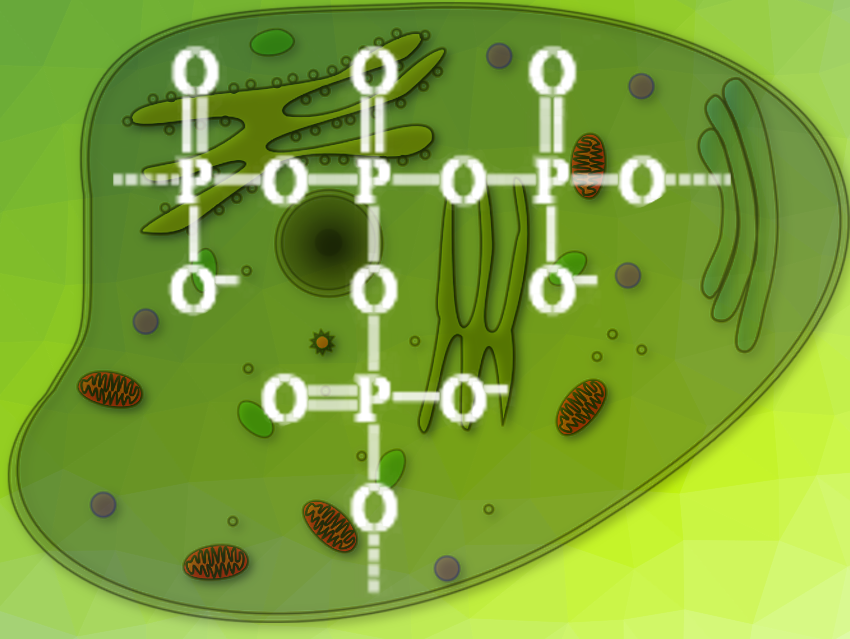Accepted wisdom that branched polyphosphates could not exist in cells, but Henning Jessen from the University of Freiburg, Germany, and colleagues have questioned this assumption. They synthesized the smallest version of branched condensed phosphates, a tetraphosphate, and found that the molecules are not inherently unable to exist in a cell, at least for short periods. Instead, there could be a host of other reasons why they have not yet been found.
Roles of Polyphosphates in Cells
Polyphosphates may have played a decisive role in the origins of life on this planet. Scientists assume that chemical reactions between high-energy inorganic polyphosphates and primitive nucleosides instigated the first ever steps in phosphorylation, making metabolism possible. A vestige of this process still lives on in the form of adenosine triphosphate (ATP), the energy carrier of the cell.
Polyphosphates usually form a linear chain of condensed phosphates bonds. An extra phosphate can be added to a chain of three either at the end or in the middle, in this case leading to a branched structure. In a watery environment, however, any branched structure hydrolyzes. Many bacteria and yeast store polyphosphates, but branched ones have never been found. This has led to the general assumption that branched polyphosphates simply don’t exist in biological cells.
Synthetic Approach
However, Jessen and colleagues argue that the reason that they have not yet been found could be the extraction conditions used in previous experiments. Polyphosphate extraction usually requires harsh treatments such as acids, divalent cations, nucleophilic agents, and drying, all of which would hydrolyze the labile phosphoanhydride bonds. Therefore, the researchers approached the problem from a different angle: they synthesized the molecules and tested their behavior under cellular conditions.
The team first devised a strategy to synthesize the smallest versions of branched polyphosphates, called ultraphosphates, which consist of a phosphate unit surrounded by three other phosphates. For synthesis, trisalkylphosphine was reacted with three equivalents of phosphates protected by an organic group. This gave a protected ultraphosphite, which, after oxidation, turned into a protected ultraphosphate.
These small, branched structures were not as labile as expected. Indeed, the most stable variants lasted “indefinitely” in the freezer, the researchers reported. After deprotection with strong bases, the free ultraphosphates slowly decomposed in water. However, this happened within hours, not immediately. Enzymes gave ultraphosphates a more difficult life. The researchers found that the enzyme alkaline phosphatase, found in many parts of the body, quickly broke down the phosphoanhydride bond at the branching point. This means ultraphosphates could in theory exist in living cells, albeit not for long periods.
Branched Phosphates “Walk” Their Way into Chains
Apart from simple hydrolysis at the branching point, the researchers also detected an interesting rearrangement reaction. For the trisadenosylated ultraphosphate, an ultraphosphate protected by adenosine, linearization occurred in aqueous solution. The linear product still carried the three adenosines, two at either end and one attached to a central phosphate.
Backed up by calculations, they proposed a two-step mechanism for this rearrangement reaction, involving nucleophilic attacks at the phosphoester or phosphoanhydride bonds. As the phosphate made its way along the phosphate line from the branching point, they dubbed this rearrangement “phosphate walk”.
Phosphorylation with Ultraphosphates
Although ultraphosphates are unstable and are attacked by enzymes, they still could be of use in a cell. The researchers found that amino acids, alcohol, and (deoxy)nucleosides were phosphorylated by ultraphosphates. This reaction sheds light on possible early phosphorylation events on primordial earth. In this nascent era of our planet’s history, volcanic activity could have produced branched condensed phosphates.
With this study, Jessen and colleagues have provided more evidence that phosphorylation of biomolecules was possible using this source of phosphates. The study also shows that ultraphosphates are not fundamentally unstable in an aqueous environment: it is just that they rearrange to give linear products, which are attacked by hydrolases. Having created stability through synthesis, the authors envision a deeper investigation of the chemistry of the branched polyphosphates.
- The Chemistry of branched condensed phosphates,
Tobias Dürr-Mayer, Danye Qiu, Verena B. Eisenbeis, Nicole Steck, Markus Häner, Alexandre Hofer, Andreas Mayer, Jay S. Siegel, Kim K. Baldridge, Henning J. Jessen,
Nat. Commun. 2021.
https://doi.org/10.1038/s41467-021-25668-3




